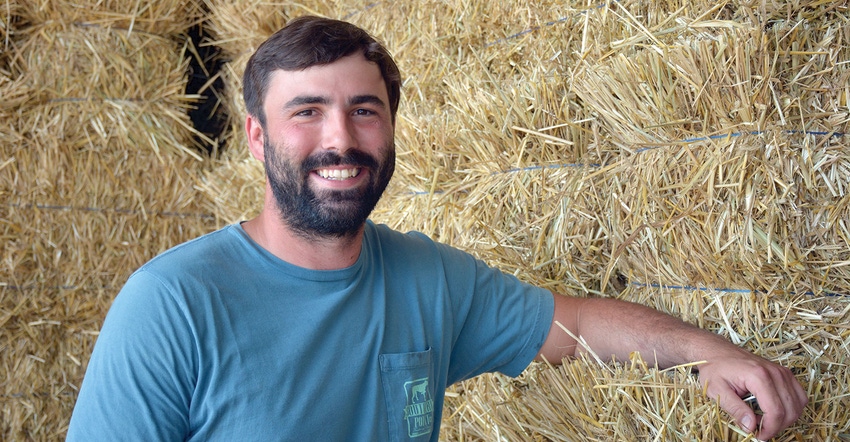
Sam Myers is finishing up a master’s degree from Iowa State this summer but readily admits that all he’s ever wanted to do is farm. Sam, 27, says his brother, Benten, 21, feels the same. They represent the third generation currently working a hay, cattle and row crop operation in Coffee County, Tenn.
“We both have always wanted to farm,” Myers says. “I hope we can pass it along to our children one day, too.”
The farm includes 1,100 acres of row crops — corn and soybeans — and 600 to 700 acres of hay, including pure Timothy and pure orchardgrass meadows. They have 60 mama cows.
“What sets us apart from other hay producers,” Myers says, “is double cropping. The lower cost of Timothy and orchardgrass seed allows us to do that.” Planting soybeans behind hay limits the season to one cutting. “But we fertilize well and try to get 100 bales per acre on that one cutting.” Those are small, square bales, mostly headed to the horse market in Georgia, Texas, and Alabama.
They also cut wheat and cereal rye for straw. “We have a strong straw market in Tennessee,” he says. They cut forage wheat for haylage.
The row crops mesh well with hay. “It’s a good rotation,” says Myers. He no-tills soybeans into the hay stubble but plants corn in the hay fields every two or three years. “We have a ryegrass problem, including some Roundup-resistance. We can grow corn and use completely different chemistry to control ryegrass and other weeds.”
No-till everything
The combination of hay and row crops also leaves “something on the ground year-round. We no-till everything,” Myers says. “Grass makes a good rotation crop.”
They plant soybeans in June, after hay cutting, and plant all Xtend varieties. We used half and half Extend and Roundup Ready last year. “We will use XtendiMax or Engenia, just one pass,” he says. He says following the dicamba herbicide labels and paying close attention to weather conditions, especially wind speed and direction, will be critical with other crops in the mix.
“We are using the Xtend varieties mostly for the genetics. They make good yields.” He says Asgrow soybeans have done well. “We have some Becks this year, too.”
Soybeans take more acres than corn this year. “The corn has been planted and we have about 600 acres of soybeans left to plant,” he said in late May.
The hay operation has been the basic enterprise for more than 40 years. “My Great grandfather started the hay business in the 1970s or ’80s. That was a hard time for farmers,” he says. “He had grown row crops but prices were low. Since then, we’ve always been in hay.”
His grandfather, Kerry, and his father, Mark, are still active in the operation.
Good yields
Myers says they make good yields from hay fields and produce about 70,000 small, square bales a year. “We have two bale wagons that make the process more efficient. Not many try to tend as many acres of hay as we do.” The hay wagons help.
Weather is a constant threat. In May he was concerned about a field of alfalfa, the first they had grown in five years. “With a 40 percent chance of rain, it’s hard to decide when to cut alfalfa,” he says. He was planning on double-cropping beans behind that alfalfa.
Myers says he works closely with the nearby co-ops. “We buy from them and they buy straw from us,” he says. “We try to do business with the folks who do business with us.”
About the Author(s)
You May Also Like






